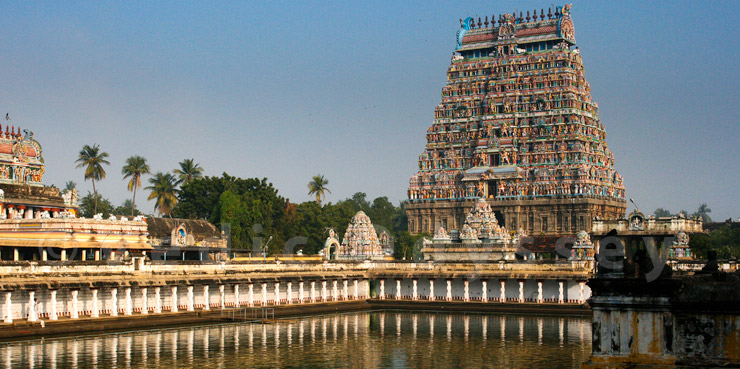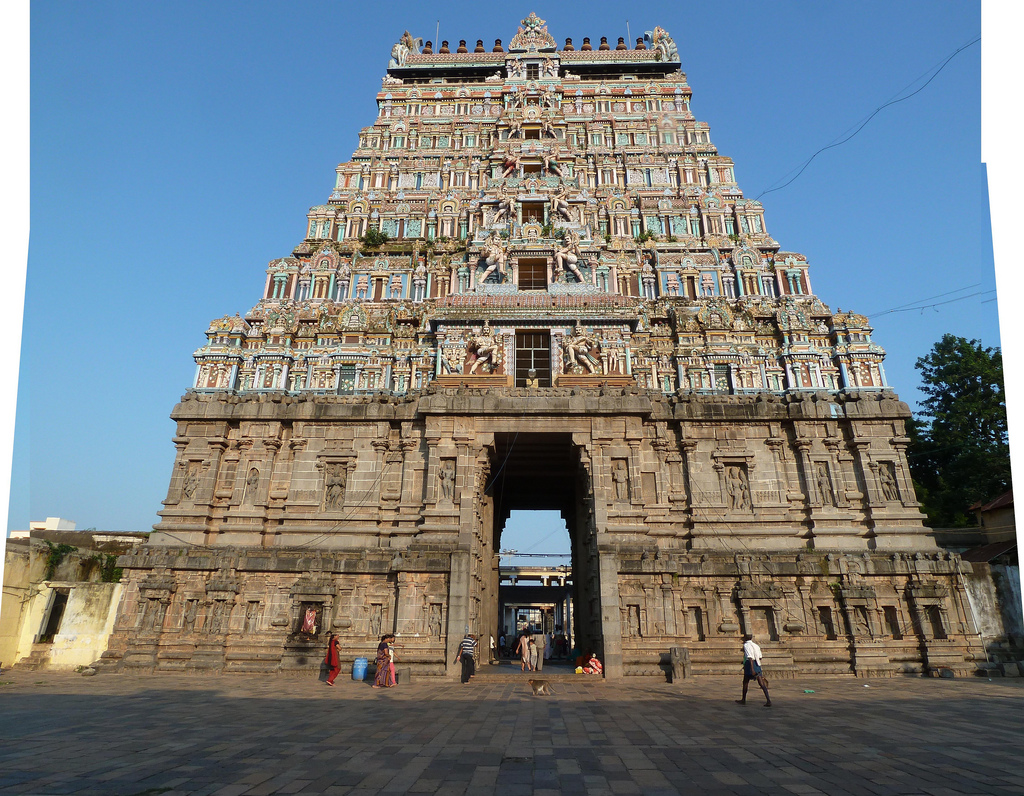Nataraja Temple at Chidambaram
Chidambaram is an ancient South Indian town famous for its Shiva temple with imposing towers. It is in the Cuddalore district of Tamil Nadu. Temples in Tamil Nadu are famous for their Dravidian architecture. They have imposing towers and sculptures with intricate details.
 A trip to Chidambaram is an experience you will cherish for a long time. Stay overnight and wake up to the sound of temple bells in the morning. A quintessential temple town in Tamil Nadu, Chidambaram provides a great introduction to South India.
A trip to Chidambaram is an experience you will cherish for a long time. Stay overnight and wake up to the sound of temple bells in the morning. A quintessential temple town in Tamil Nadu, Chidambaram provides a great introduction to South India.
There are several tourist attractions in Chidambaram. The most famous, of course, is the majestic temple dedicated to Lord Shiva. Here Shiva is worshipped as Nataraja (The lord of dance). Because of this reason Chidambaram is a sacred place for Shaivites (worshippers of Lord Shiva).
Tamil Nadu has 5 Shiva temples associated with the five elements (air, water, earth, fire and wind). The one at Chidambaram is associated with air. Chidambaram means akash (sky or ether). The other four Shiva temples are Kalahasti Nathar Temple (wind), Thiruvannamalai Arunachaleswara (fire), Kanchi Ekambareswara temple (earth) and Thiruvanaikaval Jambukeswara (water).

The imposing tower of the Nataraja Temple at Chidambaram
The temple at Chidambaram is perhaps the only temple where Shiva is worshipped as Nataraja. In all other temples, the Lord is worshipped as the Shivalinga (the phallic symbol). Another interesting thing about this temple is that here Lord Shiva and Lord Vishnu are worshipped side by side. Vishnu is worshipped as Govindaraja Perumal. This makes Chidambaram an important pilgrimage center for the Vaishnavites as well. The temple derives its traditional name Tillai Nataraja Kovil from the forests of Tillai trees surrounding it.
The temple is spread over an area of 40 acres. The presiding deity is Lord Shiva. The temple complex also contains shrines to Shivakami Amman (an incarnation of Parvati), Ganesh, Murugan (the eldest son of Shiva and Parvati) and Vishnu in the form Govindaraja Perumal. The golden roof of the temple was laid by the Chola King Parantaka I (907-950 CE). The temple received generous donations from the Chola kings.
There are numerous temples in Chidambaram. There were built by different dynasties during different eras. A large number of them have been renovated and restored to their original glory. These temples are a reflection of the architectural skills of Dravidas.
When to visit
Chidambaram has mild weather throughout the year. The temperature ranges from 33 degrees Celsius to 24 degrees Celsius. April, May and June are the hottest months and December and January are the coldest months. Chidambaram receives little rainfall. Except occasional rains if you visit in November or December.
How to reach Chidambaram
Chidambaram is well-connected by road, rail and air. It is close to Chennai (150 kilometers). Tourists coming from distant places should get off at Chennai International Airport and travel to the temple town by road or rail.
Most tourists indulge in a bit of shopping while they are at Chidambaram. The place is famous for its indigenous handicrafts. Come here to buy a piece of history and heritage.
The annual chariot festival of the temple held in the Tamil month of Marghazhi (December-January) attracts of thousands of pilgrims and tourists alike.
Legend
As per one popular legend, Lord Shiva was once strolling through the Thillai forest. Some sages who lived in this forest believed in the supremacy of magic and witchcraft. They believed that even God could be controlled with their rituals and mantras. Shiva wanted to prove them wrong. He assumed the form of a bhikshu (a young sage who lives on alms) and approached the sages for alms. The wives of the sages got enchanted by this handsome bhikshu. This infuriated the sages. By performing some cryptic rituals they summoned scores of serpents. Shiva lifted the serpents and donned them as ornaments around his waist, neck and matted locks. This act of the Bhikshu enraged the sages further. They summoned a fierce tiger. There ensued a battle between the bhikshu and the tiger. In the end the tiger was killed and skinned by the bhikshu who wrapped the animal’s skin around his waist. The sages then invoked a fierce elephant. Shiva killed him too. Little did the sages realize that they were fighting the Lord. Not willing to concede defeat, they gathered all of their spiritual powers and created a fierce demon called Muyalakan. Smiling gently, the bhikshu pulled the demon to the ground. Stepping on his back, he performed Ánanda Tandava (the celestial dance of eternal bliss). He then revealed his true form. The sages fell at his feet. They realized that no ritual or practice can control God.
The temple must have been built during the 6th or 7th century. Since the Sangam literature written between the first and the fifth centuries makes no mention of the temple, it is safe to assume that it was built after this period. What’s more, three poet saints who lived in the 7th century have immortalized the temple and its deity in their works.